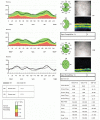Effects of multiple intravitreal anti-VEGF injections on retinal nerve fiber layer and intraocular pressure: a comparative clinical study
- PMID: 23638426
- PMCID: PMC3633763
- DOI: 10.3980/j.issn.2222-3959.2013.02.20
Effects of multiple intravitreal anti-VEGF injections on retinal nerve fiber layer and intraocular pressure: a comparative clinical study
Abstract
Aim: To determine the effect of multiple injections of ranibizumab or bevacizumab on retinal nerve fiber layer (RNFL) and intraocular pressure (IOP) in patients with age-related macular degeneration (AMD).
Methods: This retrospective study includes 35 eyes of 35 patients treated with intravitreal bevacizumab (IVB, 1.25mg/0.05mL) and 30 eyes of 30 patients with intravitreal ranibizumab (IVR, 0.5mg/0.05mL) who had Fast RNFL analysis (Stratus™); IOP measurements were taken 30 minutes and 24 hours after each injection.
Results: The mean ages were 68.0±7.5 and 69.1±7.7 years in the IVR and IVB groups, respectively (P=0.55). They underwent (6.3±1.9) and (5.1±1.3) injections (P=0.07) over (13.6±2.1) and (14.05±2.6) months (P=0.45) in the IVR and IVB groups, respectively. Changes in overall and temporal RNFL thickness in IVR-treated eyes (105.3±6.9µm and 74.4±11.2µm) were not different from those in untreated eyes in the IVR group (104.6± 8.4µm and 75.1±12.6µm) (P=0.57 and P=0.41, respectively). Similarly, overall and temporal RNFL thickness in IVB-treated eyes (105.8±8.1µm and 74.5±11.8µm) were not different from those in untreated eyes in the IVB group (104.6±8µm and 74.8±12.9µm) (P=0.42 and P=0.80, respectively). The frequencies of IOP rise (P=0.60) and changes in RNFL thickness from baseline (P=0.16) were comparable between groups.
Conclusion: Repeated intravitreal injection of ranibizumab or bevacizumab does not seem have adverse effects on RNFL thickness or IOP in wet AMD patients.
Keywords: adverse effect; anti-VEGF; bevacizumab; intraocular pressure; ranibizumab; retinal nerve fiber layer.
Figures
Similar articles
-
The effect of multiple injections of ranibizumab on retinal nerve fiber layer thickness in patients with age-related macular degeneration.Curr Eye Res. 2015 Jan;40(1):87-92. doi: 10.3109/02713683.2014.917190. Epub 2014 May 28. Curr Eye Res. 2015. PMID: 24871814
-
Longitudinal Changes in Retinal Nerve Fiber Layer Thickness after Intravitreal Anti-vascular Endothelial Growth Factor Therapy.Korean J Ophthalmol. 2016 Apr;30(2):114-20. doi: 10.3341/kjo.2016.30.2.114. Epub 2016 Mar 25. Korean J Ophthalmol. 2016. PMID: 27051259 Free PMC article.
-
Effects of the Presence of Pseudoexfoliation on Intraocular Pressure and Retinal Nerve Fiber Layer Thickness in Patients with Macular Degeneration Receiving Intravitreal Ranibizumab.Clin Pract. 2022 Jan 19;12(1):78-83. doi: 10.3390/clinpract12010009. Clin Pract. 2022. PMID: 35200261 Free PMC article.
-
Intravitreal Anti-Vascular Endothelial Growth Factor Therapy and Retinal Nerve Fiber Layer Loss in Eyes With Age-Related Macular Degeneration: A Meta-Analysis.Invest Ophthalmol Vis Sci. 2016 Apr;57(4):1798-806. doi: 10.1167/iovs.15-18404. Invest Ophthalmol Vis Sci. 2016. PMID: 27077733 Review.
-
Comparison of intravitreal bevacizumab and ranibizumab used for myopic choroidal neovascularization: A PRISMA-compliant systematic review and meta-analysis of randomized controlled trials.Medicine (Baltimore). 2019 Mar;98(12):e14905. doi: 10.1097/MD.0000000000014905. Medicine (Baltimore). 2019. PMID: 30896642 Free PMC article.
Cited by
-
The effects of intravitreal injections on intraocular pressure and retinal nerve fiber layer: a systematic review and meta-analysis.Sci Rep. 2020 Aug 6;10(1):13248. doi: 10.1038/s41598-020-70269-7. Sci Rep. 2020. PMID: 32764619 Free PMC article.
-
Effect of intravitreal ranibizumab and aflibercept injections on retinal nerve fiber layer thickness.Sci Rep. 2021 Mar 3;11(1):5010. doi: 10.1038/s41598-021-84648-1. Sci Rep. 2021. PMID: 33658584 Free PMC article.
-
Changes in Retinal Nerve Fiber Layer Thickness after Multiple Injections of Novel VEGF Decoy Receptor Conbercept for Various Retinal Diseases.Sci Rep. 2016 Dec 6;6:38326. doi: 10.1038/srep38326. Sci Rep. 2016. PMID: 27922068 Free PMC article.
-
Short-term effect of intravitreal brolucizumab injections in patients with neovascular age-related macular degeneration on retinal nerve fiber layer thickness.Sci Rep. 2023 Apr 24;13(1):6685. doi: 10.1038/s41598-023-32024-6. Sci Rep. 2023. PMID: 37095122 Free PMC article.
-
Influence of Multiple Anti-VEGF Injections on Retinal Nerve Fiber Layer and Ganglion Cell-Inner Plexiform Layer Thickness in Patients with Exudative Age-Related Macular Degeneration.Medicina (Kaunas). 2023 Jan 10;59(1):138. doi: 10.3390/medicina59010138. Medicina (Kaunas). 2023. PMID: 36676762 Free PMC article.
References
-
- Ganssauge M, Wilhelm H, Bartz-Schmidt KU, Aisenbrey S. Non-arteritic anterior ischemic optic neuropathy (NA-AION) after intravitreal injection of bevacizumab (Avastin) for treatment of angoid streaks in pseudoxanthoma elasticum. Graefes Arch Clin Exp Ophthalmol. 2009;247(12):1707–1710. - PubMed
-
- Battaglia Parodi M, Iacono P, Cascavilla ML, Zucchiatti I, Kontadakis DS, Vergallo S, Bandello F. Sequential anterior ischemic optic neuropathy and central retinal artery and vein occlusion after ranibizumab for diabetic macular edema. Eur J Ophthalmol. 2010;20(6):1076–1078. - PubMed
-
- Tseng JJ, Vance SK, Della Torre KE, Mendonca LS, Cooney MJ, Klancnik JM, Sorenson JA, Freund KB. Sustained increased intraocular pressure related to intravitreal antivascular endothelial growth factor therapy for neovascular age-related macular degeneration. J Glaucoma. 2012;21(4):241–247. - PubMed
-
- Kahook MY, Kimura AE, Wong LJ, Ammar DA, Maycotte MA, Mandava N. Sustained elevation in intraocular pressure associated with intravitreal bevacizumab injections. Ophthalmic Surg Lasers Imaging. 2009;40(3):293–295. - PubMed
LinkOut - more resources
Full Text Sources
Other Literature Sources

